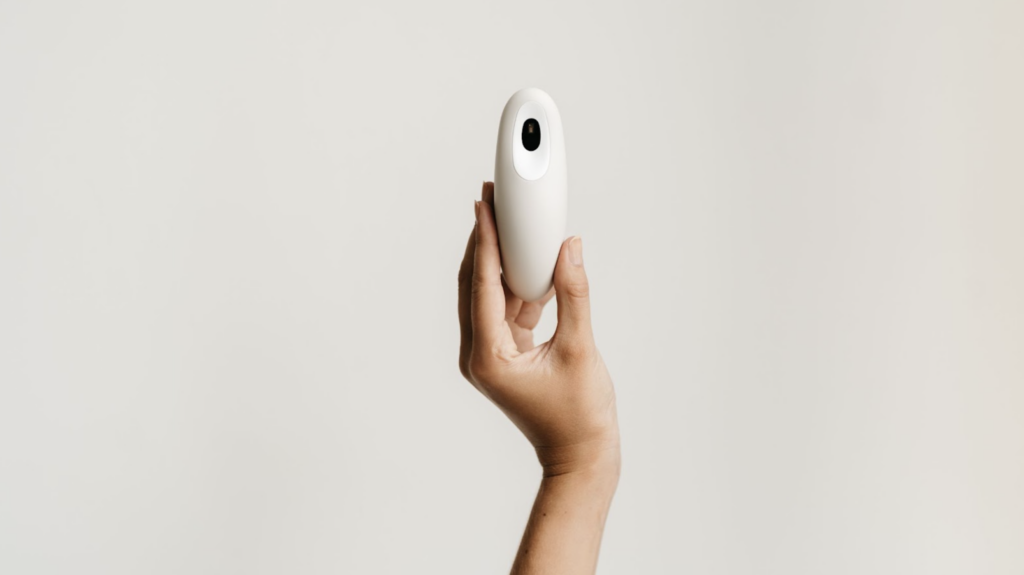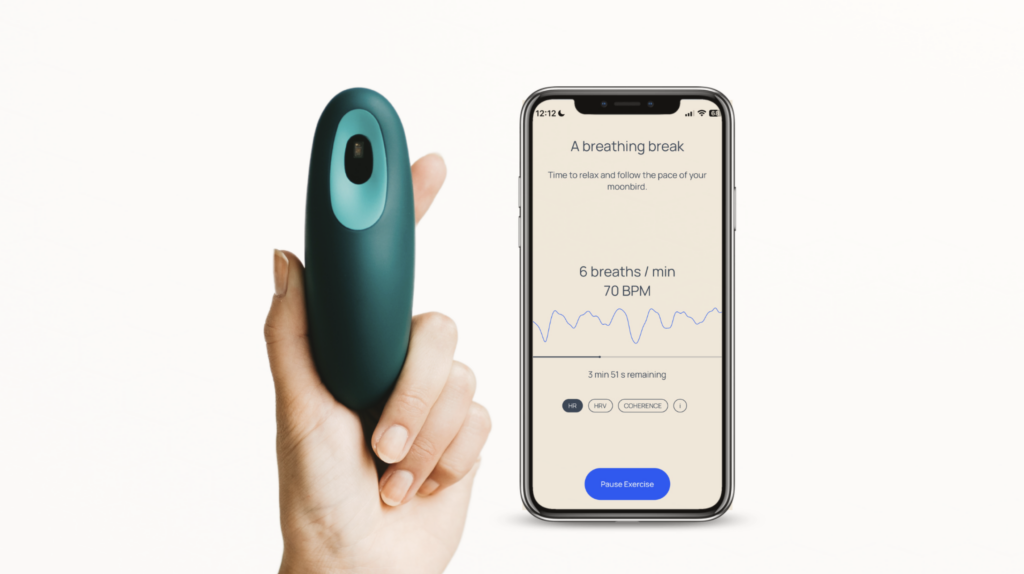Welcome to this edition of our interview series, where we talk to founders on a mission to help us live better, calmer, more connected lives. Stefanie Broes is the founder of Moonbird, the world’s first handheld breathing coach. Moonbird is a physical breathing guide: it expands and contracts in the hand, providing you a slow pace to match with your breathing rhythm.
In this interview, we talked about the benefits of slow breathing, how to use real-time biofeedback to regulate your nervous system, breathwork as a tool for stress management, and much more. Enjoy the read!

Hi Stefanie, thanks for agreeing to this interview! First, can you tell us about the benefits of slow breathing?
Slow breathing is a simple yet powerful technique with a multitude of science-backed benefits. By breathing more slowly and controlled, we activate our parasympathetic nervous system, the relaxation system of our body. This effectively dials down stress and anxiety, by inducing a state of calm and relaxation.
The physical benefits of slow breathing are noticeable rather fast. In fact, a recent study from 2021 conducted in 61 healthy participants, found that a short breathing exercise of only five minutes already led to significant increases in parasympathetic activity compared to a control condition. After some practice you will start to notice the psychological benefits too. One of these benefits is enhanced sleep quality, making breathing exercises a useful tool for those battling insomnia.
Interestingly, slow breathing plays a significant role in cognitive enhancement, sharpening focus, and memory. For individuals dealing with burnout or chronic stress, it can be a game-changer, aiding in recovery and restoring balance to the mind and body. In essence, slow breathing is more than just a relaxation technique; it’s a gateway to holistic well-being, offering mental peace and physical strength.
And what inspired you to help people practice slow breathing?
For me, my journey with slow breathing exercises started about five years ago. At that time, I developed severe insomnia as a result of my PhD thesis and the pressure that comes along with it. I was trying to figure out which next career step I would like to take, when I started to experiment with different meditation techniques.
I followed courses, read all of the books, went to a coach to help me; and then finally discovered the breath as a tool to rebalance and calm down my nervous system. What I found fascinating is that breathing exercises are super effective, but also work quite fast. Within minutes, you can breathe yourself more calmly or you can breathe yourself to sleep. For me, being an insomniac, I found that intriguing to say the least.
I am a scientist by training, and so when I learned all about this, I dove into the science behind this domain to understand how breathing exercises work and why they work. What data was there to back this up? And I basically found this whole scientific field of research where there is just so much validation on these techniques, not only in insomnia, but for many other use cases like anxiety, stress, burnout, pain management…
But even though there was a lot of evidence out there, there were only little innovations built upon these techniques. Hence, when I was completely convinced of the impact of breathing exercises, and I started to apply these techniques but struggled to implement these myself, I wanted to develop tools to enable people to discover the benefits of slow breathing exercises, and ultimately made this my lifelong mission.
Moonbird is quite unique in the sense that it’s a physical self-care tool you can hold in your hand.
Yes! Breath pacers are devices or applications that guide users through sensory stimuli (eg. visually, auditory, or sensory) to adjust their breathing patterns. Typically, they employ rhythms or cues to help the user breathe more slowly, a practice known as paced breathing. By following these cues, you can easily focus on the exercises and synchronize your breathing with a rhythm that promotes relaxation and stress reduction.
Moonbird offers a handheld, tactile breathing experience. Users hold the device, which expands and contracts, guiding the breathing rhythm. Like a small bird, breathing in your hands.
The only thing you need to do is mimic the rhythm of the device with your breathing. This can be especially beneficial for those seeking a more physical connection to their breath-pacing practice. Users can set different rhythms, and optionally receive biofeedback and audio guidance.
The design was deliberately chosen. When I started to use other breathing pacer, I was not a big fan of visual, or auditory stimuli that guided my breath. They felt as if they took much more cognitive capacity from my brain and actually kept me awake, instead of helping me to doze off to sleep.
Ultimately, I thought of a parent cradling their baby to sleep: when the parent holds the baby, and the baby feels how the parent is breathing at a slow pace, this in itself creates a calming and soothing experience. That’s what I wanted to mimic. I wanted to use our sense of touch to guide people, hence we needed to develop a tactile device. Something that breathes for you, where you literally feel how you need to breathe without having to think of focus so much.
With this in mind, I reached out to my brother. He came over to dinner one night, was a big fan of the idea, and hence we started co-creating the device. We started off with a fruit basket that was on the table in order to find an organic shape that felt comfortable. We tried a pear, an apple, a lemon, and finally ended up with the shape of an avocado. Then we reached out to doctors, end users and business people with this basic concept to help us start our venture.
That’s an amazing origin story. The app also gives you real-time biofeedback. Can you tell us more?
The Moonbird app’s real-time biofeedback is a game-changer in personalized relaxation practices. By providing data on heart rate (HR), heart rate variability (HRV), and coherence, users gain deep insights into their physical state. HRV, in particular, is a critical measure of the autonomic nervous system’s balance, reflecting the interplay between the sympathetic (stress response) and parasympathetic (relaxation response) systems.
Users can see how their breathing affects their HRV in real-time, allowing them to adjust their breathing rhythm for optimal relaxation and stress reduction. This level of personalization was crucial for us to implement because it empowers users to understand and control their body’s stress response, making the practice of breathwork more effective and meaningful.

Some people find it hard to build a habit around their breathing practice. Do you have any tips?
Consistency is key in developing a habit around breathing practice. Creating a personal sanctuary or a dedicated space for relaxation can be incredibly beneficial. It sets a physical cue that signals your mind it’s time to unwind.
Additionally, coupling the breathing practice with another daily activity, like post-lunch relaxation or pre-bedtime routine, can make it easier to create a habit. Using Moonbird as part of these routines can help implement the practice into your daily life, making it a natural part of your stress management and self-care rituals.
How can people know whether breathwork is working for them?
One of the best ways to understand if breathwork is effective is by monitoring changes in HRV. Think of HRV as a reflection of your nervous system’s ability to regulate itself – similar to how a gas pedal and brake pedal manage a car’s speed you keep a balance between the sympathetic and parasympathetic nervous system.
A high HRV indicates a balanced and responsive nervous system, capable of adapting to stressors efficiently. By using Moonbird, you can track how different breathing techniques impact your HRV, giving you feedback on the effectiveness of your breathwork sessions. Over time, you should notice improvements in your ability to relax and handle stress or sleep better, which are clear indicators that breathwork is working for you.
What kind of people use Moonbird?
Moonbird attracts a wide range of users, each looking for different benefits. Students use it to stay calm and focused, especially during exams. Employees find it helpful for managing their high-stress environments. Parents use it to find moments of peace in their busy daily life.
Each user’s experience is unique, but they all share the common benefit of reduced stress, improved sleep quality, and overall well-being. Moonbird’s versatility in addressing these varied needs is what makes it a useful tool for so many people.
What about you, how do you use Moonbird?
Personally, I use Moonbird as a daily ritual to maintain balance. In the evening, it helps me transition from the hustle of the day into a relaxed state, preparing me for a good night’s sleep. I used to struggle a lot with falling asleep in the past, but since I’ve been doing breathing exercises and using my Moonbird before going to bed I quickly doze off.
Also, there are times when I wake up in the middle of the night and can’t sleep anymore. In those situations, I grab my Moonbird, start breathing with it, and most of the time, I fall back asleep within minutes. The ability to customize exercises and rhythms means I can tailor each session to what I need at that moment. Moonbird has become an essential tool in my daily routine.
How do you recommend someone get started?
We’ve developed a 21-day breathing plan within the app, offering tips and tricks to maximize the benefits of doing breathing exercises with Moonbird. While some people experience quick results, like falling asleep within just five minutes or feeling less stressed after their first use, it’s important to create a daily habit of practicing breathing exercises.
This consistency is essential for getting long-term results, such as increased relaxation, reduced stress and anxiety, and improved sleep. It might take some time getting used to breathing along with a device, therefore we advise to start with short daily breathing exercises of about three to five minutes, a few times a day. After about three weeks, you should start noticing the first positive effects.
And finally… What’s next for Moonbird?
Currently, our main focus is on expanding into the US and UK markets. Our ultimate goal is to help more people feel better and breathe better, worldwide. As part of this mission, we’re also starting the development of a Moonbird product for children. We’ve noticed a lot of interest from parents and caregivers who want to provide this solution to their kids.
Thank you so much for your time, Stefanie! Where can people learn more about Moonbird?
Thank you for having me! You can learn more on our website and follow our journey on Instagram.
